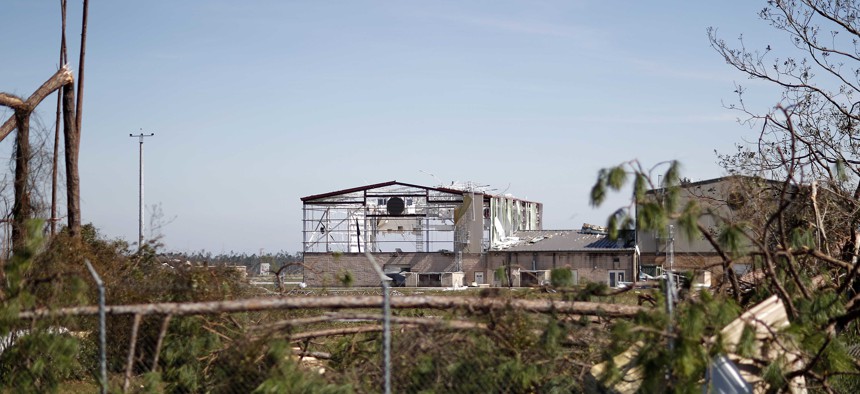
An airplane hangar at Tyndall Air Force Base, which was not included in DOD's climate change report, is damaged from hurricane Michael in Panama City, Fla., Thursday, Oct. 11, 2018. ap photo/david goldman
Lawmakers Tell Pentagon: Revise and Resubmit Your Climate-Change Report
The most recent one didn’t even meet the legal requirements contained in the 2018 defense authorization act.
The Pentagon’s latest climate-change report was so bad that it didn’t even meet legal requirements, say House lawmakers who on Wednesday ordered the military to redo the document by April 1.
The report “lacks key deliverables,” according to the Jan. 25 letter from House Armed Services Chairman Rep. Adam Smith, D-Wash., Rep. Jim Langevin, D-R.I., and Rep. John Garamendi, D-Calif. released last week.
The Pentagon’s 2019 climate report opens with the line: “The effects of a changing climate are a national security issue with potential impacts to Department of Defense missions, operational plans, and installations.”
But the report goes downhill from there, said David Titley, the Navy meteorologist-turned-Penn State professor.
“The highlight of the report was the first sentence of the opening paragraph where it did clearly state that climate change was one of the risks the DOD needs to be concerned about,” Titley said. “That’s about as good as I can say.”
The report, “Report on Effects of a Changing Climate to the Department of Defense,” released four weeks late on Jan. 16, was required by the Langevin Amendment, part of the 2018 Defense Authorization Act.
Spearheaded by Rep. Jim Langevin, D-R.I., the bill ordered the Pentagon to list the top 10 military installations most vulnerable to climate change, mitigations needed to maintain resiliency, and the potential effects on DOD missions.
Titley, a former Oceanographer of the Navy who now teaches at Pennsylvania State University, said he would have awarded DOD between a C- and a D+. “If you assign a 1,500-word essay, sometimes students will just put down 1,500 words. It doesn’t mean they answered the question,” he said.
Langevin and Smith, who serve on the House Armed Services Committee, blasted the report soon after its release.
“It is unacceptable that the Department has ignored the clear instructions provided by law, and it is unacceptable that our service members and readiness will suffer as a result,” Langevin said in a statement.
John Conger, a former DOD deputy comptroller who now directs the Center for Climate and Security, said the assignment was clear, and had been written to help DOD address the issues climate change presented.
“I think Congress was looking for specific analysis that would help them prioritize resources and then try and look at where to direct investments and resilience,” Conger said. “This report is less helpful in doing that than they intended it to be.”
In the report, which DOD said cost $329,000 to produce, Pentagon officials looked at whether 79 bases were currently experiencing or might in the future experience five natural phenomena: recurrent flooding, drought, desertification, wildfires, and thawing permafrost. It also described efforts to mitigate threats, listing studies commissioned on wildfire risk in 2014 in sensors that determine subsurface ice levels at northern bases.
But critics said the report left out a lot of required elements. For example, it mentions Tyndall Air Force Base, which was decimated by Hurricane Michael in 2018, but does not evaluate its climate risk. The 79 bases include no overseas bases, nor any that belong to the Marine Corps. Most striking to Conger was the absence of the list of the top 10 most vulnerable installations, a list specifically requested in the amendment.
“Even if they thought it would be too difficult to do, they don’t explain why they didn’t answer the question,” he said. “There are gaps.”
Titley said some of the information presented in the report is inaccurate. For example, it says the Naval Observatory was at current and future risk of drought. “I was at the Naval Observatory during the time they talk about this. I do not recall any drought,” he said. “There were no operational impacts on the Naval Observatory.”
“When you read things like these, I think it’s really unfortunate, because I think the DOD diminishes credibility with the Congress when they put things like that in the report,” he said.
Conger said there was a kernel of hope in that the report indicates that DOD leaders are not among the climate-change deniers elsewhere in the U.S. government.
DOD is “paying attention to climate change,” Conger said. “They have been for multiple administrations, Republican and Democratic, well before the Obama administration. They have been consistent in their belief that climate change is a thing they have to pay attention to and deal with…That is reflected in this report.”
Pentagon leaders have prepared several previous climate reports, both on their own initiative and at the behest of Congress. In 2014, DOD issued the Climate Change Adaptation Roadmap, which Conger said is still used as a framework for DOD’s response to climate change. The following year, Congress formally requested a review of climate risks to each combatant command, which DOD met with a report that asserted that climate change is “a present security threat, not strictly a long-term risk.” In January 2018, DOD conducted an “initial look” at which global installations were most threatened by climate change through a Screening Level Vulnerability Assessment Survey. The report concluded that such a survey was best used to identify which sites merited further assessment, and was just a “first step” in mitigating climate threats to DOD missions.



